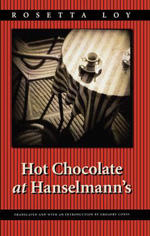

Bison Books (Univ.of Nebraska), paperback, 9780803280069
Rosetta Foy's enrapturing Hot Chocolate at Hanselmann's opens in Rome, in the comfortable home of Enrico and Isabella, on the threshold of the Second World War. Arturo is a family friend; he teaches at the university, and just so happens to be Jewish. As time passes by, Arturo's life is ever increasingly restricted by the state, until he can no longer make a living or go about his daily life.
The Second World War is a popular setting for stories of survival, and Arturo is determined to survive the war at all costs. We follow Arturo as he journeys around France, Italy and Switzerland sidestepping the Nazis and trying to find a safe haven, and we witness the lengths he has to go to achieve this. We also follow the lives of the Arnitz family who meet Arturo: Isabella, Margot, Lorenza, and Eddy.
Foy shows great skill in her plotting and characterisation, and that sets this novel apart from more romantic examples. The story does not unfold in a linear or chronological order; Foy chooses Lorenza as narrator, the daughter of Isabella and the connection between the Italian side of the family and the Swiss who Lorenza stays with in the holidays. She has "the gaze of the little girl who investigates everything that is happening around her" (from the introduction by Gregory Conti, in Foy's own words). We are presented with a fitful, alternating narrative where the characters relive events to inform Lorenza's account of the past and then move forward thirty years to join Lorenza in her present.
The characters are not one-dimensional cardboard cutouts; Arturo is sometimes callous and unpredictable, but determined and passionate. The jovial Signora Arnitz welcomes Arturo to her idyllic home, Chesa Silvascina, in Switzerland, and into the life of her daughter Margot, only realizing later that Arturo is Jewish. Until her death, she shows her prejudice and bitterness in what she perceives as being double crossed by 'Ein Teufel' or a devil. Margot falls in love with Arturo, 'a violent love, consumed by its own desire, with no tenderness'. Margot is vivacious and adventurous and will do anything to save Arturo.
Loy has seven published novels in Italy and a memoir which seeks to dissect the treatment of the Jewish population in fascist Italy from 1939. The contrast in Hot Chocolate at Hanselmann's between the comfort and wealth of the Italian Catholic family and the deteriorating treatment of the Jewish population is compelling: between Arturo's worn and tattered clothes and Isabella wearing 'a black overcoat adorned with a collar made from some poor unidentified beast', or later Arturo when watches as the Jewish population of Nice are evicted from their properties.
Hot Chocolate at Hanselmann's is reminiscent of The Jewish Husband by Lia Levi, and shares
with it an Italian point of view in recounting the story of a Holocaust survivor who ends up settling in
Israel. The dissimilarities between the two novels are significant, however; unlike Levi's hero, Arturo
does not love unconditionally—he is willing to do awful things to survive and he is a cooler, crueller
character. In this novel, Loy has successfully achieved a chronicle of life in fascist Italy as observed
by a child without romanticising the characters or turning the novel into a thriller. Hot Chocolate at
Hanselmann's is definitely worth investigating.
